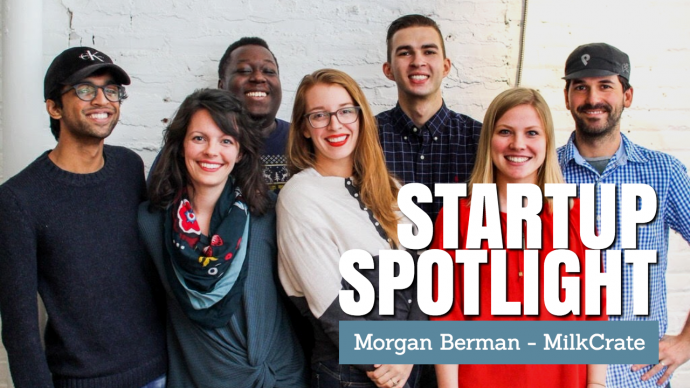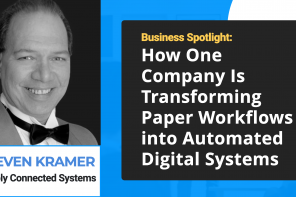Philadelphia-based startup MilkCrate, founded in September 2013, provides customizable mobile apps for nonprofits and mission-driven organizations to engage their audience, track their impact, and even earn additional financial support. Their platform uses gamification and behavioral economics to help people make better decisions.
The company’s CEO and founder Morgan Berman was selected by Forbes for the 30 Under 30 Pitch Summit, has been invited by the Obama Administration to participate in policy talks at the White House, gave a TEDx talk on chasing dreams, auditioned for Shark Tank, and won the Rad Girl Product of the Year Award.
Morgan has been featured extensively in national news outlets like the WHYY, the Philadelphia Business Journal, Boston Metro, Philadelphia Inquirer, NBC10, Forbes, Philadelphia Magazine’s Be Well Blog, and many others.
We had the pleasure to speak with Morgan for an exclusive Startup Spotlight interview:
Morgan, How did the inspiration to start MilkCrate come about?
My career started out in the nonprofit world. I was a women’s studies major and wanted to work at an organization that was dedicated to providing reproductive health care to low-income women. And that was what I did for the first couple years after college.
I worked for a few different organizations. I also worked at nonprofits focused on mental health, and at the University of Pennsylvania doing research in the surgery department.
I had a pretty wide range of experiences working at impact-focused organizations. And I experienced firsthand the financial instability that they can deal with. I was at Penn when my grant ran out my job ended. When I was at Planned Parenthood and funding dried up, everyone’s job got cut.
I was constantly at the whim of kind of these unstable financial models that were both hurting me personally and professionally, but also kind of impeding the progress of the organization.
I went through this crisis of wanting to find a new cause where I could find both a more stable professional growth path but also want to work at an organization and in a field where it felt like there was more of a chance to succeed.
So I went to grad school. While I was there I designed MilkCrate as my thesis for graduate school. And it has changed and evolved a lot. But what has always been an undercurrent throughout the process, a series of questions; “how do you help people live their values? How do you tie impact with action? And how do you do it in a financially sustainable way?” Answering those questions, that’s what I’m passionate about.
What problem is MilkCrate aiming to solve?
What we’ve become as a company is we are part-platform that launches apps to help organizations to engage their audience and track impact. But what we’re now working on is how do we turn that impact into a stable financial model for the organization.
We’re building apps that become a source of revenue for a nonprofit so that they are generating their own income more like a social enterprise. We’re now trying to help organizations in that way.
We’re now actually working with one of my first employers, who had reached out to us and said, “we need an app like this.” It was a pretty exciting moment, realizing that one of those organizations I worked for early on found us, without knowing it was my company, and reached out.
How is MilkCrate different from similar competitors?
Many mission-driven organizations, either a for-profit or nonprofit, have big audiences and a lot of content but have found that newsletters and social media aren’t good enough on their own. They want something more engaging, more long-term, and something more trackable and impactful.
So lots of leaders in these organizations have the thought “We should build an app.” But the thing that happens next, however, is they either wind up trying to build it themselves and realize they don’t have the in-house expertise. And then maybe they go out and reach out to a development company.
Maybe their cousin is a software engineer who works at a software development company. And then they get a quote that’s something like half a million dollars and so they just put that idea in a box and never look back. It can seem like too expensive and time-consuming of an undertaking to build software from scratch.
And this is why companies like WordPress and Wix and Weebly have been so successful in the website space. They’ve been able to make something that used to be a luxury item, that was only available through hiring experts who had access to tools that a layperson couldn’t use, and now anyone can build a website.
And so in the similar vein, MilkCrate is in a class of companies that are making native mobile apps available at a price point that most organizations can afford. The thing that we’re doing differently is we’re not just building mobile websites or mobile apps. We’re actually building native apps that are templatized and gamified. At MilkCrate, we build apps with a purpose.
We’re providing the wraparound support to grow and engage your audience. We’re also providing the analytics and the monetization strategy.
VC, Angel Investors or Bootstrapped?
We have raised funding from angel investors, as well as from Ben Franklin Technology Partners. We did a small convertible note round and now we’re closing out our seed round.
As a tech company, you often have a lot of upfront costs and if you don’t have the personal capital to do it it’s got to come from somewhere. Most banks won’t give you a loan to build a tech platform from scratch. We decided to work with mission-aligned investors and early stage angels who are excited about the prospect of what we’re building from both the financial and impact perspective.
What is the greatest lesson you’ve learned so far?
Learning to breathe. Not necessarily stepping back, but learning how to be present in the moment and to not let it grip you. It’s one of the lessons I’ve been kind of co-learning with my Jiu-Jitsu training.
If you could have anyone in the world to your team, who would you choose?
Well, I don’t know all of the people in the world so I’m probably leaving out some key people I’m sure. But I recently actually found an advisor who’s felt just like an absolutely perfect fit at the right time.
And I’m really happy to have him in my orbit now because he has built and sold a company where a huge part of their work was helping nonprofits engage and monetize their audience. He has been really instrumental in how we think about the next phase of our company, and how we’re going to be able to help our clients.
We’ve had clients who’ve been building apps with us now for a while, that are benefiting what we currently offer. We enable them to launch a customized app that engages their audience with their content and where they can track engagement and track impact. And we want to do more. And the next phase of the company is how do we expand on that monetization piece. And that’s where his expertise has really helped shape our thinking.
So that’s been huge. But I’m just extremely grateful for the people that we have right now. We’re always looking for someone who’s a leader at an organization much larger than ours that is serving our target demographic of mission-driven organizations. Either that’s running a foundation that’s funding these organizations, or is a provider of a solution that we could complement. There are some really big tech companies out there that are providing solutions to our target demographic that we could compliment really well.
Those are the kinds of people that I would love to be working with.
Your favorite team building activity is:
I was a camp counselor, and I kind of run the company with some of those lessons I learned. I joke about this all the time, but it’s really true. So every Wednesday we do ‘rose and thorn,’ which is something I did with my campers where we share the best and worst thing going on for us.
And then we also do ‘appreciations.’ Being thankful and giving thanks to each other is one of the best things you can do to build a positive attitude and sense of team cohesion. So we practice that every week.
And then after we do that, we all clean the office. We don’t have an outside cleaning crew come in. It’s like bunk cleanup. We made the mess, so we’re going to clean it up. It creates a sense of ownership and a feeling of “no one’s too good to clean the bathroom.”
Where do you envision MilkCrate in 5 to 10 years?
I think by then we will have most likely partnered with a much larger company to make our vision come to life at a much more global scale. I’m on the board of Philly Startup Leaders and one of the things we’re always thinking about is how do we attract these bigger companies to set up an HQ here in Philadelphia.
And I think my dream would be to partner with one of those companies and have our partnership be a thing that sets up a much larger tech presence here in Philadelphia through some of the relationships we might be able to build over the coming years.
The biggest thing you look for when hiring is:
The thing that I really look for is someone who has a clear drive to grow, learn and contribute. Someone who really gets excited about working with a team to build something special and impactful.
We’ve hired a lot of people who have been in a job where they felt like a cog in a machine and they want to be more creative. They want to have more responsibility and they want to see a direct line of impact from the work that they’re doing to something getting better out in the world.
And that’s like a real tangible thing that we deliver when we launch an app for organizations, like the Committee of Seventy. We built apps to help get people out voting for the midterms, and we launched the Concilio app for the largest Hispanic cultural organization in the city that has challenges in their app like “click here to become a foster parent.” That is what is really exciting, to see the impact we’re having on the world every day.
We want to be hiring people that are excited about that work. We want to be hiring a really diverse workforce, in every sense of the word. In terms of their backgrounds, the work that they’ve done, their education, and their demographics.
As a female founder, I’m lucky enough to know from a firsthand perspective how important diversity of thought is. We want to build a team that is diverse in ethnicity, race, linguistics, gender and sexual orientation, and nationality. And so much more. We benefit so much from a diverse range of voices and abilities. We could be doing better and I am always thinking about how we can do better to be more inclusive and equitable and diverse.
One of the wonderful things that we’ve had, because we’re in Philadelphia, is access to Co-op programs at Drexel and internships from Phila U and Penn that have really diverse and even international students who intern here. Because of this, we’ve had so many students from so many different countries and that’s been a really wonderful way that we’ve been able to expand our team and hire some of them and benefit from that wide range of human experience.
What advice would you give to entrepreneurs just starting out?
Well, I had that opportunity recently when I was speaking at the Pennsylvania Conference for Women. Someone came up to me and said, “I built this app, it’s about to launch. What advice do you have for me?”
And I said, “Well, did you show the design or the concept to any of your target users or customers before you built it?” And she said no. And my heart sank. Because that is just the absolute worst thing you can ever do, is build something without showing anyone or getting feedback along the way.
My number one piece of advice is to assume that you’re wrong about pretty much everything and put all of your energy go into proving yourself wrong, by getting as much feedback as you can from your target users and customers. Using wireframes, sketches, conversations, whatever it takes.
Anything and everything you can do to get you working with that first customer. Not even a full MVP, just a mockup that helps you sell that first customer. Get somebody to commit to giving you money for what you envisioned or partially built. Because that’s really going to be the mark of success, solving someone’s pain point enough that they’re willing to pay for it.
Want to learn how you can help your organization make an impact?
At MilkCrate, we serve leaders of organizations all over the world.
Today we invite you to discover your leadership archetype and get resources to help you be more effective. The assessment takes two minutes, but the impact will be long-lasting.
Discover Your Leadership Archetype – Click Here For Your Free Assessment
Learn more and connect with Morgan:
https://milkcrate.tech
https://twitter.com/morganberman
www.linkedin.com/in/morganberman




